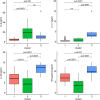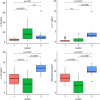Endotyping Seasonal Allergic Rhinitis in Children: A Cluster Analysis
- PMID: 35155483
- PMCID: PMC8825866
- DOI: 10.3389/fmed.2021.806911
Endotyping Seasonal Allergic Rhinitis in Children: A Cluster Analysis
Abstract
Background: Seasonal Allergic Rhinitis (SAR) is a heterogeneous inflammatory disease. We hypothesized that a cluster analysis based on the evaluation of cytokines in nasal lavage (NL) could characterize distinctive SAR endotypes in children.
Methods: This cross-sectional study enrolled 88 children with SAR. Detailed medical history was obtained by well-trained physicians. Quality of life and sleep quality were assessed through standardized questionnaires [Pediatric Rhinoconjunctivitis Quality of Life Questionnaire (PRQLQ) and Pittsburgh Sleep Quality Index (PSQI) respectively]. Children were grouped through K-means clustering using Interleukin (IL)-5, IL-17, IL-23, and Interferon (INF)-γ in NL.
Results: Out of the 88 patients enrolled, 80 were included in the cluster analysis, which revealed three SAR endotypes. Cluster 1 showed lower levels of IL-5 and IL-17 and intermediate levels of IL-23 and IFN-γ; Cluster 2 had higher levels of IL-5 and intermediate levels of IL-17, IL-23, and IFN-γ; Cluster 3 showed higher levels of IL-17, IL-23, and IFN-γ and intermediate levels of IL-5. Cluster 1 showed intermediate values of nasal pH and nasal nitric oxide (nNO), and a lower percentage of neutrophils at nasal cytology than Clusters 2 and 3. Cluster 2 had a lower level of nasal pH, a higher nNO, higher scores in the ocular domain of PRQLQ, and worse sleep quality than Clusters 1 and 3. Cluster 3 showed a higher percentage of neutrophils at nasal cytology than Clusters 1 and 2.
Conclusions: Our study identified three endotypes based on the evaluation of cytokines in NL, highlighting that childhood SAR is characterized by heterogeneous inflammatory cytokines.
Keywords: allergic rhinitis; children; cluster analysis; cytokines; endotypes.
Copyright © 2022 Malizia, Ferrante, Cilluffo, Gagliardo, Landi, Montalbano, Fasola, Profita, Licari, Marseglia and La Grutta.
Conflict of interest statement
The authors declare that the research was conducted in the absence of any commercial or financial relationships that could be construed as a potential conflict of interest. The reviewer RC declared past collaborations with the authors AL and GLM to the handling editor.
Figures



Similar articles
-
Efficacy of Buffered Hypertonic Saline Nasal Irrigation for Nasal Symptoms in Children with Seasonal Allergic Rhinitis: A Randomized Controlled Trial.Int Arch Allergy Immunol. 2017;174(2):97-103. doi: 10.1159/000481093. Epub 2017 Oct 24. Int Arch Allergy Immunol. 2017. PMID: 29059673 Clinical Trial.
-
Measuring quality of life in children with rhinoconjunctivitis.J Allergy Clin Immunol. 1998 Feb;101(2 Pt 1):163-70. doi: 10.1016/s0091-6749(98)70380-x. J Allergy Clin Immunol. 1998. PMID: 9500748
-
Distinct Endotypes of Pediatric Rhinitis Based on Cluster Analysis.Allergy Asthma Immunol Res. 2022 Nov;14(6):730-741. doi: 10.4168/aair.2022.14.6.730. Allergy Asthma Immunol Res. 2022. PMID: 36426400 Free PMC article.
-
Upper and lower airway pathology in young children with allergic- and non-allergic rhinitis.Dan Med Bull. 2011 May;58(5):B4278. Dan Med Bull. 2011. PMID: 21535990 Review.
-
Nasal nitric oxide and nasal allergy.Allergy. 2006 Jun;61(6):665-70. doi: 10.1111/j.1398-9995.2006.01096.x. Allergy. 2006. PMID: 16677234 Review.
Cited by
-
Nasal Nitric Oxide in Children: A Review of Current Outreach in Pediatric Respiratory Medicine.Children (Basel). 2023 Oct 9;10(10):1671. doi: 10.3390/children10101671. Children (Basel). 2023. PMID: 37892334 Free PMC article. Review.
-
Clinical relevance of cluster analysis in phenotyping allergic rhinitis in the paediatric population of the Kuyavian-Pomeranian voivodeship, Poland.Postepy Dermatol Alergol. 2024 Feb;41(1):56-65. doi: 10.5114/ada.2023.135676. Epub 2024 Feb 28. Postepy Dermatol Alergol. 2024. PMID: 38533360 Free PMC article.
-
Artificial intelligence in pediatric allergy research.Eur J Pediatr. 2024 Dec 21;184(1):98. doi: 10.1007/s00431-024-05925-5. Eur J Pediatr. 2024. PMID: 39706990 Free PMC article. Review.
-
Intra-cervical lymphatic immunotherapy for dust mite-induced allergic rhinoconjunctivitis in children: a 3-year prospective randomized controlled trial.Front Immunol. 2023 Aug 1;14:1144813. doi: 10.3389/fimmu.2023.1144813. eCollection 2023. Front Immunol. 2023. PMID: 37593733 Free PMC article. Clinical Trial.
References
LinkOut - more resources
Full Text Sources
Miscellaneous

